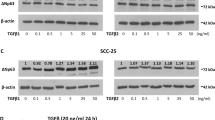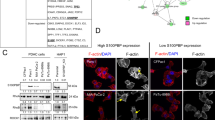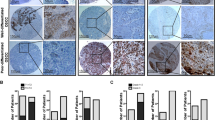Abstract
Overexpression of S100A7 (psoriasin), a small calcium-binding protein, has been associated with the development of psoriasis and carcinomas in different types of epithelia, but its precise functions are still unknown. Using human tissue specimens, cultured cell lines, and a mouse model, we found that S100A7 is highly expressed in preinvasive, well-differentiated and early staged human squamous cell carcinoma of the oral cavity (SCCOC), but little or no expression was found in poorly differentiated, later-staged invasive tumors. Interestingly, our results showed that S100A7 inhibits both SCCOC cell proliferation in vitro and tumor growth/invasion in vivo. Furthermore, we demonstrated that S100A7 is associated with the β-catenin complex, and inhibits β-catenin signaling by targeting β-catenin degradation via a noncanonical mechanism that is independent of GSK3β-mediated phosphorylation. More importantly, our results also indicated that β-catenin signaling negatively regulates S100A7 expression. Thus, this reciprocal negative regulation between S100A7 and β-catenin signaling implies their important roles in tumor development and progression. Despite its high levels of expression in early stage SCCOC tumorigenesis, S100A7 actually inhibits SCCOC tumor growth/invasion as well as tumor progression. Downregulation of S100A7 in later stages of tumorigenesis increases β-catenin signaling, leading to promotion of tumor growth and tumor progression.
This is a preview of subscription content, access via your institution
Access options
Subscribe to this journal
Receive 50 print issues and online access
$259.00 per year
only $5.18 per issue
Buy this article
- Purchase on Springer Link
- Instant access to full article PDF
Prices may be subject to local taxes which are calculated during checkout








Similar content being viewed by others
References
Adhikary S, Eilers M . (2005). Transcriptional regulation and transformation by Myc proteins. Nat Rev Mol Cell Biol 6: 635–645.
Alowami S, Qing G, Emberley E, Snell L, Watson PH . (2003). Psoriasin (S100A7) expression is altered during skin tumorigenesis. BMC Dermatol 3: 1.
Bienz M, Clevers H . (2000). Linking colorectal cancer to Wnt signaling. Cell 103: 311–320.
Blanpain C, Horsley V, Fuchs E . (2007). Epithelial stem cells: turning over new leaves. Cell 128: 445–458.
Broome AM, Ryan D, Eckert RL . (2003). S100 protein subcellular localization during epidermal differentiation and psoriasis. J Histochem Cytochem 51: 675–685.
Di Nuzzo S, Sylva-Steenland RM, Koomen CW, De Rie MA, Das PK, Bos JD et al. (2000). Exposure to UVB induces accumulation of LFA-1+ T cells and enhanced expression of the chemokine psoriasin in normal human skin. Photochem Photobiol 72: 374–382.
Donato R . (2001). S100: a multigenic family of calcium-modulated proteins of the EF-hand type with intracellular and extracellular functional roles. Int J Biochem Cell Biol 33: 637–668.
Donato R . (2003). Intracellular and extracellular roles of S100 proteins. Microsc Res Tech 60: 540–551.
Emberley ED, Niu Y, Curtis L, Troup S, Mandal SK, Myers JN et al. (2005). The S100A7-c-Jun activation domain binding protein 1 pathway enhances prosurvival pathways in breast cancer. Cancer Res 65: 5696–5702.
Emberley ED, Niu Y, Leygue E, Tomes L, Gietz RD, Murphy LC et al. (2003a). Psoriasin interacts with Jab1 and influences breast cancer progression. Cancer Res 63: 1954–1961.
Emberley ED, Niu Y, Njue C, Kliewer EV, Murphy LC, Watson PH . (2003b). Psoriasin (S100A7) expression is associated with poor outcome in estrogen receptor-negative invasive breast cancer. Clin Cancer Res 9: 2627–2631.
Enerback C, Porter DA, Seth P, Sgroi D, Gaudet J, Weremowicz S et al. (2002). Psoriasin expression in mammary epithelial cells in vitro and in vivo. Cancer Res 62: 43–47.
Filipek A, Jastrzebska B, Nowotny M, Kuznicki J . (2002). CacyBP/SIP, a calcyclin and Siah-1-interacting protein, binds EF-hand proteins of the S100 family. J Biol Chem 277: 28848–28852.
Fukushima T, Zapata JM, Singha NC, Thomas M, Kress CL, Krajewska M et al. (2006). Critical function for SIP, a ubiquitin E3 ligase component of the beta-catenin degradation pathway, for thymocyte development and G1 checkpoint. Immunity 24: 29–39.
Hart M, Concordet JP, Lassot I, Albert I, del los Santos R, Durand H et al. (1999). The F-box protein beta-TrCP associates with phosphorylated beta-catenin and regulates its activity in the cell. Curr Biol 9: 207–210.
He TC, Sparks AB, Rago C, Hermeking H, Zawel L, Da Costa LT et al. (1998). Identification of c-MYC as a target of the APC pathway. Science 281: 1509–1512.
Heizmann CW, Fritz G, Schafer BW . (2002). S100 proteins: structure, functions and pathology. Front Biosci 7: d1356–d1368.
Hoffmann HJ, Olsen E, Etzerodt M, Madsen P, Thogersen HC, Kruse T et al. (1994). Psoriasin binds calcium and is upregulated by calcium to levels that resemble those observed in normal skin. J Invest Dermatol 103: 370–375.
Kennedy RD, Gorski JJ, Quinn JE, Stewart GE, James CR, Moore S et al. (2005). BRCA1 and c-Myc associate to transcriptionally repress psoriasin, a DNA damage-inducible gene. Cancer Res 65: 10265–10272.
Kitagawa M, Hatakeyama S, Shirane M, Matsumoto M, Ishida N, Hattori K et al. (1999). An F-box protein, FWD1, mediates ubiquitin-dependent proteolysis of beta-catenin. EMBO J 18: 2401–2410.
Korinek V, Barker N, Morin PJ, van Wichen D, De Weger R, Kinzler KW et al. (1997). Constitutive transcriptional activation by a beta-catenin-Tcf complex in APC−/− colon carcinoma. Science 275: 1784–1787.
Krop I, Marz A, Carlsson H, Li X, Bloushtain-Qimron N, Hu M et al. (2005). A putative role for psoriasin in breast tumor progression. Cancer Res 65: 11326–11334.
Leygue E, Snell L, Hiller T, Dotzlaw H, Hole K, Murphy LC et al. (1996). Differential expression of psoriasin messenger RNA between in situ and invasive human breast carcinoma. Cancer Res 56: 4606–4609.
Liu J, Stevens J, Rote CA, Yost HJ, Hu Y, Neufeld KL et al. (2001). Siah-1 mediates a novel beta-catenin degradation pathway linking p53 to the adenomatous polyposis coli protein. Mol Cell 7: 927–936.
Martinsson H, Yhr M, Enerback C . (2005). Expression patterns of S100A7 (psoriasin) and S100A9 (calgranulin-B) in keratinocyte differentiation. Exp Dermatol 14: 161–168.
Matsuzawa SI, Reed JC . (2001). Siah-1, SIP, and Ebi collaborate in a novel pathway for beta-catenin degradation linked to p53 responses. Mol Cell 7: 915–926.
Moog-Lutz C, Bouillet P, Regnier CH, Tomasetto C, Mattei MG, Chenard MP et al. (1995). Comparative expression of the psoriasin (S100A7) and S100C genes in breast carcinoma and co-localization to human chromosome 1q21-q22. Int J Cancer 63: 297–303.
Moon RT, Kohn AD, De Ferrari GV, Kaykas A . (2004). WNT and beta-catenin signalling: diseases and therapies. Nat Rev Genet 5: 691–701.
Morin PJ, Weeraratna AT . (2003). Wnt signaling in human cancer. Cancer Treat Res 115: 169–187.
Patel JH, Loboda AP, Showe MK, Showe LC, McMahon SB . (2004). Analysis of genomic targets reveals complex functions of MYC. Nat Rev Cancer 4: 562–568.
Reischl J, Schwenke S, Beekman JM, Mrowietz U, Sturzebecher S, Heubach JF . (2007). Increased expression of Wnt5a in psoriatic plaques. J Invest Dermatol 127: 163–169.
Taketo MM . (2004). Shutting down Wnt signal-activated cancer. Nat Genet 36: 320–322.
Tavakkol A, Zouboulis CC, Duell EA, Voorhees JJ . (1994). A retinoic acid-inducible skin-specific gene (RIS-1/psoriasin): molecular cloning and analysis of gene expression in human skin in vivo and cultured skin cells in vitro. Mol Biol Rep 20: 75–83.
van de Wetering M, Sancho E, Verweij C, De Lau W, Oving I, Hurlstone A et al. (2002). The beta-catenin/TCF-4 complex imposes a crypt progenitor phenotype on colorectal cancer cells. Cell 111: 241–250.
Watson PH, Leygue ER, Murphy LC . (1998). Psoriasin (S100A7). Int J Biochem Cell Biol 30: 567–571.
Willert K, Jones KA . (2006). Wnt signaling: is the party in the nucleus? Genes Dev 20: 1394–1404.
Yigitbasi OG, Younes MN, Doan D, Jasser SA, Schiff BA, Bucana CD et al. (2004). Tumor cell and endothelial cell therapy of oral cancer by dual tyrosine kinase receptor blockade. Cancer Res 64: 7977–7984.
Acknowledgements
This work was supported by the National Institute of Dental and Craniofacial Research—NIH grant RO1DE01461301 and the NIH Cancer Center support grant CA16672 and CA69381. We thank Mrs Carol Johnston for the excellent technical assistance. We thank Dr PD McCrea, Dr M-C Hung, Dr X-W Wu, Dr E Fearon and Dr GP Nolan for providing plasmids.
Author information
Authors and Affiliations
Corresponding author
Additional information
Supplementary Information accompanies the paper on the Oncogene website (http://www.nature.com/onc).
Supplementary information
Rights and permissions
About this article
Cite this article
Zhou, G., Xie, TX., Zhao, M. et al. Reciprocal negative regulation between S100A7/psoriasin and β-catenin signaling plays an important role in tumor progression of squamous cell carcinoma of oral cavity. Oncogene 27, 3527–3538 (2008). https://doi.org/10.1038/sj.onc.1211015
Received:
Revised:
Accepted:
Published:
Issue Date:
DOI: https://doi.org/10.1038/sj.onc.1211015
Keywords
This article is cited by
-
Decreased brain-expressed X-linked 4 (BEX4) expression promotes growth of oral squamous cell carcinoma
Journal of Experimental & Clinical Cancer Research (2016)
-
Reactive oxygen species and p21Waf1/Cip1 are both essential for p53-mediated senescence of head and neck cancer cells
Cell Death & Disease (2015)
-
Joining S100 proteins and migration: for better or for worse, in sickness and in health
Cellular and Molecular Life Sciences (2014)
-
Psoriasin (S100A7) associates with integrin β6 subunit and is required for αvβ6-dependent carcinoma cell invasion
Oncogene (2011)
-
Loss of ICAM-1 signaling induces psoriasin (S100A7) and MUC1 in mammary epithelial cells
Breast Cancer Research and Treatment (2011)



